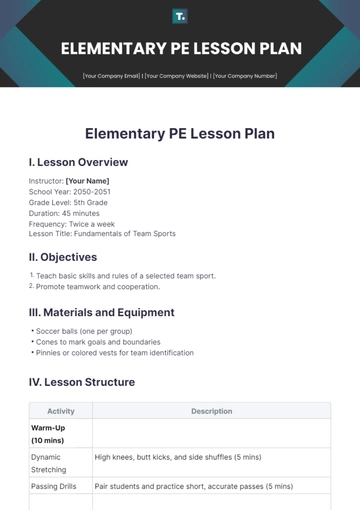Free Elementary Teacher Lesson Plan

Prepared By | [YOUR NAME] |
|---|---|
Email Address | [YOUR EMAIL] |
I. Lesson Overview:
This engaging lesson is tailored for elementary students to embark on an exciting journey through our solar system. Students will delve into the mysteries of space as they explore the planets, their unique characteristics, and their intriguing orbits around the sun. By incorporating interactive activities and visual aids, this lesson aims to captivate students' interest and deepen their understanding of our cosmic neighborhood.
II. Learning Objectives:
By the end of this lesson, students will be able to:
Identify the eight planets in the solar system and their distinctive features.
Describe the physical characteristics and key attributes of each planet.
Understand the concept of orbit and recognize the relationship between the planets and the sun.
III. Materials Needed:
Materials | Description |
|---|---|
Textbooks or resources | Educational materials about the solar system |
Pictures or models | Visual aids depicting the planets |
Art supplies | Colored pencils, markers, construction paper |
Chart paper and markers | For group activities and presentations |
Interactive websites or apps | Optional for enhanced learning experiences |
IV. Lesson Procedure:
Step | Description |
|---|---|
Introduction (10 minutes) |
|
Exploration of Planets (20 minutes) |
|
Activity: Create a Solar System Model (30 minutes) |
|
Discussion and Review (15 minutes) |
|
V. Assessment:
Assessment Method | Description |
|---|---|
Observation during activity |
|
Review of student notes/drawings |
|
Optional quiz or worksheet |
|
VI. Closure:
To effectively conclude the lesson and reinforce learning, follow these steps:
Summarize Key Points: Provide a concise summary of the main concepts covered during the lesson. Highlight the key characteristics of the planets, their positions in the solar system, and the importance of understanding these celestial bodies.
Encourage Reflection: Encourage students to reflect on their learning experiences. Prompt them to think about what they found most interesting or surprising about the solar system and to share any questions or observations they have.
Connect to Real-World Examples: Relate the lesson content to real-world examples or phenomena. Discuss how our understanding of the solar system has evolved over time and how ongoing scientific exploration continues to deepen our knowledge of space.
Preview Next Steps: Provide a brief preview of what students can look forward to in future lessons. Mention any upcoming activities, projects, or topics related to space exploration that will build upon the knowledge gained in this lesson.
Closure Activity: End the lesson with a hands-on or reflective activity to solidify learning. This could include creating a class mural of the solar system, writing a short reflection journal entry, or participating in a group discussion about the most fascinating aspects of space.
VII. Extension Activities:
To further engage students and extend their learning beyond the classroom, consider the following extension activities:
Research Projects: Assign students individual or group research projects focused on specific aspects of the solar system. Topics could include exploring the moons of Jupiter, investigating the possibility of life on Mars, or studying the history of space exploration.
Virtual Field Trips: Take students on virtual field trips to explore astronomical observatories, space museums, or interactive planetariums. Use online resources and virtual reality tools to provide immersive experiences that enhance understanding and spark curiosity.
Guest Speakers: Invite guest speakers, such as astronomers, scientists, or astronauts, to share their expertise and experiences with the class. Arrange virtual or in-person presentations followed by Q&A sessions where students can ask questions and learn from professionals in the field.
STEM Challenges: Design STEM (science, technology, engineering, and mathematics) challenges that encourage students to apply their knowledge of the solar system to solve problems or complete hands-on activities. Examples include building model rockets, designing Mars rovers, or constructing solar system scale models.
Creative Projects: Encourage students to express their understanding of the solar system through creative projects such as artwork, multimedia presentations, or original stories set in space. Provide opportunities for students to showcase their creations and share them with their peers or the wider school community.
[YOUR COMPANY NAME]
[YOUR COMPANY ADDRESS]
[YOUR COMPANY WEBSITE]
- 100% Customizable, free editor
- Access 1 Million+ Templates, photo’s & graphics
- Download or share as a template
- Click and replace photos, graphics, text, backgrounds
- Resize, crop, AI write & more
- Access advanced editor
Enhance your classroom efficiency with the Elementary Teacher Lesson Plan Template from Template.net. This fully customizable and editable template ensures you stay organized and focused on teaching. Effortlessly tailor your lesson plans to fit your needs using the AI Editor Tool. Ideal for elementary teachers seeking a reliable solution to streamline their planning process.















